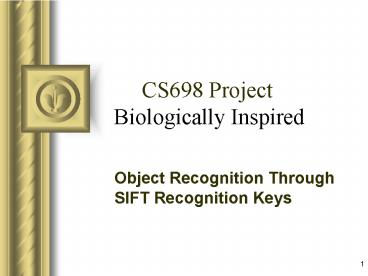CS698 Project Biologically Inspired PowerPoint PPT Presentation
1 / 19
Title: CS698 Project Biologically Inspired
1
CS698 ProjectBiologically Inspired
- This presentation will probably involve audience
discussion, which will create action items. Use
PowerPoint to keep track of these action items
during your presentation - In Slide Show, click on the right mouse button
- Select Meeting Minder
- Select the Action Items tab
- Type in action items as they come up
- Click OK to dismiss this box
- This will automatically create an Action Item
slide at the end of your presentation with your
points entered.
- Object Recognition Through SIFT Recognition Keys
2
Motivation
- Vision sense modality conveying huge
information - Object Recognition Tough task
- Biological vision recognize objects under
different - Orientations
- illuminations
- and at different scales
3
SIFT key algorithm by Lowe
- SIFT stands for scale invariant feature transform
- Provides features for object recognition
- Patented by university of British Columbia
- Similar to the one used in primate visual system
4
Other work/approaches
- Object segmentation and correlation maximization
- Eigenspace matching
- Isolated objects / pre-segmented image
- Schmid Mohr Harris Corner detector to identify
interest points, create a local image decriptor
vector i.e. independent of orientation - Examines at a single scale
5
Steps
- Scale space peak selection
- Potential locations for finding features
- Key point Localization
- Accurately locating the feature key
- Orientation Assignment
- Assigning orientation to the keys
- Key point descriptor
- Describing the key as a high dimensional vector
6
Scale space peak selection
- Scale space of an image is defined as
- L(x,y,sig)G(x,y,sig)I(x,y)
- Locating stable key points by repeatedly
smoothing and downsampling an input image and
subtracting adjacent levels to create a pyramid
of difference-of-Gaussian image. - D(x,y,sig) L(x,y,ksig) L(x,y,sig)
7
Scale space pyramid
8
Peak detection
9
Key point localization
- To the first approximation the location of key is
the place where peak is detected - Better Fit a 3D paraboloid through the
neighboring points to locate the maxima in the
scale space - Reject those points with a low contrast value
- Eliminate poor edge locations
10
(No Transcript)
11
Orientation assignment Finding gradient
magnitude m and orientation theta
12
Orientation histogram
- Orientation histogram formed from the gradient
orientations at all sample points within a
circular window around the key point. - Each sample added to the histogram is weighted by
its gradient magnitude and by Gaussian with sigma
3 times that of the current scale. - 36 bins covering 360 degrees
13
Assigning orientation
- Locate peaks in the histogram
- Highest peak is detected and those lying within
80 of it are also detected and used to create
different keys at the same location. - 15 of the points are assigned multiple
orientation - Contribute significantly to the stability of
matching
14
Local Image descriptor
- Again orientation histograms are formed (with
relative orientation) - 4X4 region around the key point
- Magnitude weighted with gaussian
- 8X4X4128 element feature vector normalized to
reduce effect of illumination change - No gradient magnitude is allowed to be greater
than 0.2 - Threshold at 0.2
- renormalized
15
Key point descriptor
16
Similarity to IT cortex
- Complex neurons respond to a gradient at a
particular orientation. - Location of the feature can shift over a small
receptive field. - Edelman, Intrator, and Poggio (1997) hypothesized
that the function of the cells is allow for
matching and recognition of 3D objects from a
range of view points. - Experiments show better recognition accuracy for
3D objects rotated in depth by up to 20 degrees
17
Key point matching
- Match the key points against a database of that
obtained from training images. - Find the nearest neighbor i.e. a keypoint with
minimum Euclidean distance. - Efficient Nearest Neighbor matching
- Best bin first algorithm a modification of k-d
tree search - Approx solution
- Second nearest neighbor distance restriction
18
Further Improvements
- Clustering keys together
- Hough transform
- Solution to affine transforms
19
Bibliography
- Distinctive image features from scale-invariant
keypoints - David G. Lowe, accepted for publication in the
International Journal of Computer Vision, 2004.
- Object recognition from local scale-invariant
features - David G. Lowe, International Conference on
Computer Vision, Corfu, Greece (September 1999),
pp. 1150-1157. - Local feature view clustering for 3D object
recognition, - David G. Lowe, IEEE Conference on Computer Vision
and Pattern Recognition, Kauai, Hawaii (December
2001), pp. 682-688. - Invariant Features from Interest Point Groups,
- Matthew Brown and David G. Lowe British Machine
Vision Conference, BMVC 2002, Cardiff, Wales
(September 2002). - Local grayvalue invariants for image retrievals,
- Schmid, C., and R. Mohr, IEEE PAMI, 19, 5 (1997),
pp 530-34

